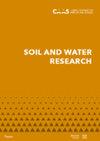Changes in the soil’s biological and chemical properties due to the land use
IF 1.7
4区 农林科学
Q4 SOIL SCIENCE
引用次数: 4
Abstract
Increasing the soil productivity is challenged by the increasing biotic threat to plants and microorganisms, by the resistance to agrochemicals, and by the declining soil health. Soil management strategy is, therefore, aimed at erosion prevention and the minimisation of soil organic matter losses. A key factor in an agroecosystem is the appropriate biological stability. It is essential not only at present, but also for further sustainable agriculture. This study was based on the hypothesis that afforestation and conversion from arable land to permanent grassland improves the organic matter status and biological stability in the agroecosystem. The experiment was conducted from 2014 to 2018 in the Uhřice bio-corridor (Kroměříž region, the Czech Republic). Haplic Luvisol has been investigated for its basic biological and chemical properties after the arable land was converted to a natural vegetation system. The afforested segment (F), permanent grassland segment (G), and arable land segment (A) have been sampled in the upper soil horizon (0–0.30 m). Standard analytical methods were applied for the determination of the basic soil properties. A principal component analysis and factor analysis were used for interpreting the connection between the parameters of the soil organic carbon, the humic substances, the humic acids, and the fulvic acids, the agrochemical properties of the soil (the pH, the content of the nitrogen, phosphorus and potassium, etc.), and the soil biological properties (basal soil respiration (BSR), the ratios of the N/BSR, NG/BSR, etc.). After five years of investigation, the differences in the studied parameters were evident. The factor analysis and multivariate exploratory techniques showed that the soil properties were grouped based on the management into three different categories – F, G and A. The different land use directly influenced the quality and stability of the humic substances, basal soil respiration, and carbon and nitrogen utilisation. In comparison to the arable land, the forest and grassland were considered to have a higher accumulation potential of carbon and nitrogen. A negative correlation between the soil basal respiration (r = –0.95); total nitrogen (r = –0.93); total organic carbon (Cox) content (r = –0.82); and partial Ca (r = –0.82) was found. A positive correlation (r = 0.80) between the humic substances (C-HS) and soil reaction (pH) was determined.土地利用引起的土壤生物和化学性质的变化
提高土壤生产力面临着对植物和微生物日益增加的生物威胁、对农用化学品的抗性以及土壤健康状况下降的挑战。因此,土壤管理战略的目标是防止侵蚀和尽量减少土壤有机质损失。农业生态系统的一个关键因素是适当的生物稳定性。这不仅对当前,而且对进一步的可持续农业都是至关重要的。本研究基于这样的假设:造林和退耕还林改善了农业生态系统的有机质状况和生物稳定性。实验于2014年至2018年在Uhřice生物走廊(捷克共和国Kroměříž地区)进行。在耕地转化为天然植被系统后,对其基本的生物化学性质进行了研究。在土壤上层(0-0.30 m)取样造林段(F)、永久草地段(G)和耕地段(A),采用标准分析方法测定土壤基本性质。采用主成分分析和因子分析方法,对土壤有机碳、腐植酸、腐植酸、黄腐酸参数、土壤农化特性(pH、氮、磷、钾含量等)和土壤生物特性(基础土壤呼吸(BSR)、N/BSR、NG/BSR等)之间的关系进行分析。经过五年的调查,研究参数的差异是明显的。因子分析和多变量探索技术表明,不同的土地利用方式将土壤性质分为F、G和a三类,不同的土地利用方式直接影响腐殖质质量和稳定性、土壤基础呼吸和碳氮利用。与耕地相比,森林和草地具有更高的碳氮积累潜力。与土壤基础呼吸呈负相关(r = -0.95);总氮(r = -0.93);总有机碳(Cox)含量(r = -0.82);部分Ca (r = -0.82)。腐殖质(C-HS)与土壤反应(pH)呈显著正相关(r = 0.80)。
本文章由计算机程序翻译,如有差异,请以英文原文为准。
求助全文
约1分钟内获得全文
求助全文
来源期刊

Soil and Water Research
Water resources, Soil Science, Agriculture-WATER RESOURCES
CiteScore
4.60
自引率
0.00%
发文量
26
审稿时长
>12 weeks
期刊介绍:
An international peer-reviewed journal published under the auspices of the Czech Academy of Agricultural Sciences and financed by the Ministry of Agriculture of the Czech Republic. Published since 2006.
Thematic: original papers, short communications and critical reviews from all fields of science and engineering related to soil and water and their interactions in natural and man-modified landscapes, with a particular focus on agricultural land use. The fields encompassed include, but are not limited to, the basic and applied soil science, soil hydrology, irrigation and drainage of lands, hydrology, management and revitalisation of small water streams and small water reservoirs, including fishponds, soil erosion research and control, drought and flood control, wetland restoration and protection, surface and ground water protection in therms of their quantity and quality.
 求助内容:
求助内容: 应助结果提醒方式:
应助结果提醒方式:


